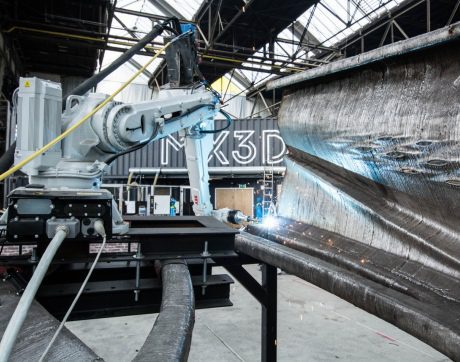A Digital Twin to Make Amsterdam’s 3D-Printed Steel Bridge Smarter and Safer

Amsterdam, Netherlands : Amsterdam-based startup MX3D is 3D printing a 12-meter-long stainless steel pedestrian bridge to be installed crossing one of Amsterdam’s canals in the old city center by late 2018. Today we announce that a consortium of mathematicians, IoT specialists and engineers have teamed up with us to develop a smart sensor network to monitor the bridge’s health in real time. A great example of data centric engineering.
The partners joining the MX3D project include: Autodesk, The Alan Turing Institute and the Amsterdam Institute for Advanced Metropolitan Solutions (AMS).
The team from The Alan Turing Institute is responsible for designing and installing a sensor network on the bridge. These sensors will collect structural measurements such as strain, displacement and vibration, and will measure environmental factors such as air quality and temperature, enabling engineers to measure the bridge’s health in real time and monitor how it changes over its lifespan. This data will also allow us to “teach” the bridge to understand what is happening on it–how many people are crossing it and how quickly.
The data from the sensors will be input into a ‘digital twin’ of the bridge, a living computer model that will reflect the physical bridge with growing accuracy in real time as the data comes in. The performance and behaviour of the physical bridge can be tested against its digital twin, which will provide valuable insights to inform designs for future 3D printed metallic structures. It will also enable the current 3D bridge to be modified to suit any required changes in use, ensuring it is safe for pedestrians under all conditions.
Autodesk is supplying the cloud services that will power the bridge’s data collection and processing. Autodesk is also working with The Alan Turing Institute researchers to develop machine learning algorithms that will enable the bridge to interpret and to react intelligently to its environment. AMS will be implementing new ways to use, visualize and connect the bridge’s data to other sources of environmental data in the Metropolitan Area of Amsterdam.
Open Call
Makers, artists and creative thinkers are invited to submit collaboration proposals that will make use of the collected data. This data will be visualized through a project website once the sensor system is installed. The team seeks proposals that focus on increased interaction between citizens and their built environment or that will create alternative, inspiring uses for smart bridge health and performance monitoring systems such as the one we are installing. The deadline for applications is 23 February 2018. Please send your (team’s) resume and a brief proposal (max. 500 words) to [email protected].
Visit MX3D
Most Friday afternoons MX3D opens the doors to its Visitor Center. The general public can get an intimate look at the printing process and the bridge. Companies can request a personalized visit at [email protected]. See http://mx3d.com/contact/ for up to date opening times and more information.
The project is supported financially by The Alan Turing Institute, Lloyd’s Register Foundation and AMS Institute (Amsterdam Institute for Advanced Metropolitan Studies) programme in data-centric engineering. Further support by Autodesk, Inc., with technical expertise and software, and several hardware partners.
About MX3D
MX3D is a company based in Amsterdam. Founded in 2014 , MX3D has researched and developed groundbreaking 3D printing technology. It has designed, produced, and distributed many custom 3D prints for variable uses such as the steel bridge.
Gijs van der Velden, Co Founder: “The MX3D technique offers engineers the freedom of working with metals in an entirely new way. The digital twin of the bridge will help with the creation of a new design language. We hope that this data-centric engineering method will speed up the introduction of this exciting new production technique into the construction market.’
About the Partners
The Lloyd’s Register Foundation: The Lloyd’s Register Foundation is a UK charity which supports the research and development of ideas that can benefit our society by reducing the safety risks of critical infrastructures.
The Alan Turing Institute: The Alan Turing Institute is the UK’s national institute for data science which aims to turn data into useful information to gain a better understanding of our society, economy, and science. The Alan Turing Institute will use the collected data to create a digital twin for the bridge. This twin can be used to validate new designs for infrastructure created by robotic additive manufacturing. By doing this, the future of digital manufacturing will be explored and new techniques will be used to improve the process.
Autodesk: Autodesk makes software for people who make things. Its role in this project is to help provide the bridge with a nervous system. This is achieved by supplying the partners with the modeling and simulation software required to design the sensor network. Additionally, Autodesk will host all data collection, storage, and processing as needed to support the digital twin model and related machine learning development.
The Amsterdam Institute for Advanced Metropolitan Solutions: AMS is a scientific institute in Amsterdam which aims to find solutions to the complex challenges Amsterdam is facing. For this project, AMS will establish a connection between other data sets in the Amsterdam Metropolitan region to understand correlations between various events across the city. AMS Institute (Amsterdam Institute for Advanced Metropolitan Solutions) was set up in Amsterdam in 2014 as a partnership between Delft University of Technology and Wageningen University & Research, in collaboration with Massachusetts Institute of Technology (MIT). AMS Institute develops knowledge and solutions for the sustainable and future-proof development of the city of Amsterdam and metropolitan areas worldwide. AMS Institute combines knowledge, education, data and network, using Amsterdam as its living lab. By exploring the possibilities of 3D printing for infrastructural use we want to contribute to re-designing public space and improve urban mobility.


